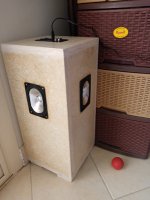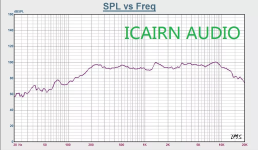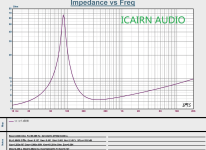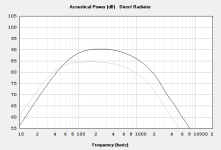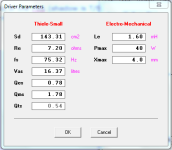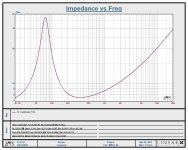Hello everyone. For some time now I have had an idea in mind with some speakers that I have on hand, bought new, for a more personal project, but due to my lack of experience, I am not completely sure if what I am going to do will behave exactly as I I think and or it will come out differently.
The idea is the following, for the project I will use two 3-inch full-range speakers with an amplitude that reaches a maximum of 90 or so on the smaller speakers. I also have two 6-inch full-range speakers, which will be the main ones. The 6-inch speakers they are a bit more special and I liked them from the very beginning and I definitely wanted to use them, especially since they have 96db amplitude. Now the idea is that I have no idea how the 4 full range loudspeakers will behave together, but I I go by the principle that they should complement each other in frequency response due to the fact that both have a very linear frequency band in theory at least. I plan to use them to create a slightly stronger sound with them, especially for music techno and electro.3-inch speakers have a resonant frequency of 65hz, while 6-inch speakers have a resonant frequency of 40hz.
As I said above, I plan to use the loudspeakers for stronger music, not necessarily of high power but of high intensity, both loudspeakers are very capable, they have been tested and I have bought amplifiers for them, as well as most of the materials,it can be called a boombox type project which I want to use in my personal space.I also have the power supplies for the amplifiers, and amplifiers for them, so for the most part I have most of the materials almost ready.
For starters, I'm thinking of going with the resonant frequency of the speakers and the recommended volume at least for the 6-inch ones (approximately 22 liters).
So far I haven't simulated anything in WinISD because I wanted to find out some opinions and possibly discuss them, anyway I plan to make the project when they are all calculated and when I have the rest of the materials.
It will not be a problem for me the space that I will allocate to the enclosure, as long as it is not absurd.
I think that the 6-inch speakers, because they will be bigger, might cover a little bit of the smaller 3-inch speakers, but I don't think that will be the case entirely.
I'm planning to make a single enclosure, which I will possibly insulate with acoustic material, or acoustic sponge, or mineral wool, anyway, it remains to be seen, I'm not completely decided.
The loudspeakers will have frequency controlled by amplifiers from a 10-band equalizer module, which will directly equalize the frequency given by the amplifier.
As volume control (gain) of the amplifiers, I will use a volume module in 12 steps with equal loudness.I could consider using the iso-barik principle for one of the speakers, to increase the amplitude, but everything I talk about in this thread will remain at the idea stage, which I may complete in a certain period.
I have already bought the speakers, amplifiers, power supplies, and modules and I will leave you a link below to the materials I will use.
the enclosure remains to be calculated and designed - not being calculated and developed, I have some idea for the enclosure and I was thinking of trying an enclosure with inverted bass speakers
Here are the materials I will use, already purchased:
-6 inch full range speakers (https://www.aliexpress.com/item/100...order_list.order_list_main.101.165e1802vVdWPb)
-3 inch full range speakers (https://www.aliexpress.com/item/100...order_list.order_list_main.232.165e1802vVdWPb)
-the equalization module in 10 bands (https://www.aliexpress.com/item/329....order_list.order_list_main.38.165e1802vVdWPb)
-the amplifier for the bigger speakers (50w) (https://www.aliexpress.com/item/100....order_list.order_list_main.60.165e1802vVdWPb)
-the amplifier for the smaller speakers (25w) (https://www.aliexpress.com/item/100....order_list.order_list_main.96.165e1802vVdWPb)
-oxygen-free copper cable of 400 cores (https://www.aliexpress.com/item/100...order_list.order_list_main.284.165e1802vVdWPb)
-binding post terminals( https://www.aliexpress.com/item/100...order_list.order_list_main.333.165e1802vVdWPb)
-volume potentiometer with loudness in 12 steps (https://www.aliexpress.com/item/100...order_list.order_list_main.278.165e1802vVdWPb)
I am waiting for some possible ideas for how I could design the enclosure and other suggestions for the enclosure are welcome.
I listen to music genres from electro, techno to hardcore techno and other genres, but I want this project to be a more serious one, so I'm waiting to exchange some opinions and suggestions about how I could make the box and what resonance would be preferable to either, and if I could improve something else in the speaker. I don't think of using filters for speakers precisely because each speaker reproduces its frequency band without being affected by each other and complementing each other.I can allocate enough volume for the smaller speaker boxes, and since the speaker itself will be a single enclosure, it will basically be individual speaker boxes in a single box.. I know it sounds complicated...
The speaker parameters can be found on the products page
The idea is the following, for the project I will use two 3-inch full-range speakers with an amplitude that reaches a maximum of 90 or so on the smaller speakers. I also have two 6-inch full-range speakers, which will be the main ones. The 6-inch speakers they are a bit more special and I liked them from the very beginning and I definitely wanted to use them, especially since they have 96db amplitude. Now the idea is that I have no idea how the 4 full range loudspeakers will behave together, but I I go by the principle that they should complement each other in frequency response due to the fact that both have a very linear frequency band in theory at least. I plan to use them to create a slightly stronger sound with them, especially for music techno and electro.3-inch speakers have a resonant frequency of 65hz, while 6-inch speakers have a resonant frequency of 40hz.
As I said above, I plan to use the loudspeakers for stronger music, not necessarily of high power but of high intensity, both loudspeakers are very capable, they have been tested and I have bought amplifiers for them, as well as most of the materials,it can be called a boombox type project which I want to use in my personal space.I also have the power supplies for the amplifiers, and amplifiers for them, so for the most part I have most of the materials almost ready.
For starters, I'm thinking of going with the resonant frequency of the speakers and the recommended volume at least for the 6-inch ones (approximately 22 liters).
So far I haven't simulated anything in WinISD because I wanted to find out some opinions and possibly discuss them, anyway I plan to make the project when they are all calculated and when I have the rest of the materials.
It will not be a problem for me the space that I will allocate to the enclosure, as long as it is not absurd.
I think that the 6-inch speakers, because they will be bigger, might cover a little bit of the smaller 3-inch speakers, but I don't think that will be the case entirely.
I'm planning to make a single enclosure, which I will possibly insulate with acoustic material, or acoustic sponge, or mineral wool, anyway, it remains to be seen, I'm not completely decided.
The loudspeakers will have frequency controlled by amplifiers from a 10-band equalizer module, which will directly equalize the frequency given by the amplifier.
As volume control (gain) of the amplifiers, I will use a volume module in 12 steps with equal loudness.I could consider using the iso-barik principle for one of the speakers, to increase the amplitude, but everything I talk about in this thread will remain at the idea stage, which I may complete in a certain period.
I have already bought the speakers, amplifiers, power supplies, and modules and I will leave you a link below to the materials I will use.
the enclosure remains to be calculated and designed - not being calculated and developed, I have some idea for the enclosure and I was thinking of trying an enclosure with inverted bass speakers
Here are the materials I will use, already purchased:
-6 inch full range speakers (https://www.aliexpress.com/item/100...order_list.order_list_main.101.165e1802vVdWPb)
-3 inch full range speakers (https://www.aliexpress.com/item/100...order_list.order_list_main.232.165e1802vVdWPb)
-the equalization module in 10 bands (https://www.aliexpress.com/item/329....order_list.order_list_main.38.165e1802vVdWPb)
-the amplifier for the bigger speakers (50w) (https://www.aliexpress.com/item/100....order_list.order_list_main.60.165e1802vVdWPb)
-the amplifier for the smaller speakers (25w) (https://www.aliexpress.com/item/100....order_list.order_list_main.96.165e1802vVdWPb)
-oxygen-free copper cable of 400 cores (https://www.aliexpress.com/item/100...order_list.order_list_main.284.165e1802vVdWPb)
-binding post terminals( https://www.aliexpress.com/item/100...order_list.order_list_main.333.165e1802vVdWPb)
-volume potentiometer with loudness in 12 steps (https://www.aliexpress.com/item/100...order_list.order_list_main.278.165e1802vVdWPb)
I am waiting for some possible ideas for how I could design the enclosure and other suggestions for the enclosure are welcome.
I listen to music genres from electro, techno to hardcore techno and other genres, but I want this project to be a more serious one, so I'm waiting to exchange some opinions and suggestions about how I could make the box and what resonance would be preferable to either, and if I could improve something else in the speaker. I don't think of using filters for speakers precisely because each speaker reproduces its frequency band without being affected by each other and complementing each other.I can allocate enough volume for the smaller speaker boxes, and since the speaker itself will be a single enclosure, it will basically be individual speaker boxes in a single box.. I know it sounds complicated...
The speaker parameters can be found on the products page
As you like music which is played louder and you have EQ I would put them on a piece of wood placed in the corner at ear height if you have place in the corner(s) . The wood forms a TML and ends on both sides in the corners some cm before the corner ends.
I recommend strongly to protect the smaller driver with a condenser of 50 to 200 microfarad or 12volt light bulb or ptc element. As this is the weak point. Capacity works best for protection. The tml line should be damped a bit

I recommend strongly to protect the smaller driver with a condenser of 50 to 200 microfarad or 12volt light bulb or ptc element. As this is the weak point. Capacity works best for protection. The tml line should be damped a bit
It's possible if you understand the limitations, but challenging. It may not be much benefit with all playing full range.
Sensitivity of 96 and 90. When these add they won't make much difference in how loud they seem, and consider how much they might interfere with each other. The bass might be reduced by partial cancellation since they have different resonances.
Sensitivity of 96 and 90. When these add they won't make much difference in how loud they seem, and consider how much they might interfere with each other. The bass might be reduced by partial cancellation since they have different resonances.
Next possibility is corner placement in a box, look my concept
with 2 fullranges
https://www.diyaudio.com/community/threads/full-range-speaker-photo-gallery.65061/post-7363120
with 2 fullranges
https://www.diyaudio.com/community/threads/full-range-speaker-photo-gallery.65061/post-7363120
Attachments
It's possible if you understand the limitations, but challenging. It may not be much benefit with all playing full range.
Sensitivity of 96 and 90. When these add they won't make much difference in how loud they seem, and consider how much they might interfere with each other. The bass might be reduced by partial cancellation since they have different resonances.
I would think of changing the resonant frequency of the smaller speakers, since the speakers will be in their own boxes, so each one will have its own resonance, the 3-inch speakers have a smaller amplitude per 40 hertz in the frequency band, although it is it is possible to raise the amplitude with the resonance of the box but not by much, so I would have thought of changing the resonant frequency of the small ones where they have more amplitude (200hz have 90 or so db) is an example
If the different woofers don't have similar sensitivity then there won't be much improvement. If one has reduced excursion, then you may be holding the other one back and getting less bass. It's usually most helpful to either run woofers on their own, or match them for running together. You should do your own investigations, or cross these instead.
By the way, here is an example of the phase problem causing response issues where two different enclosure resonances don't match. In this case one is ported.
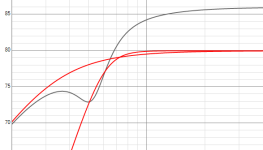
By the way, here is an example of the phase problem causing response issues where two different enclosure resonances don't match. In this case one is ported.

Set teh EQ aside for now.
Don’t see any specs for the 3”, maybe an 85 Hz Fs. If it is that low sensitivity its likely closer to 84 dB.

Lii are remowned for their poor data, looks like start it out in a sealed box(ideally about 45 litres using the provided data). I doubt very much it is anywhere near that sensitivity. Unlikely with that Fs and Vas. Unless they have a significantly rising response and are measured up there (ie Visaton B200 is rated at 95 dB but is actually more like 89 in real life). I have yet to find a whizzer cone driver that does not benefit from phase plugs.

I don’t see how you use these together other that as 2 loudspeakers, if used together the 3” as rear surrounds.
dave
Don’t see any specs for the 3”, maybe an 85 Hz Fs. If it is that low sensitivity its likely closer to 84 dB.
Lii are remowned for their poor data, looks like start it out in a sealed box(ideally about 45 litres using the provided data). I doubt very much it is anywhere near that sensitivity. Unlikely with that Fs and Vas. Unless they have a significantly rising response and are measured up there (ie Visaton B200 is rated at 95 dB but is actually more like 89 in real life). I have yet to find a whizzer cone driver that does not benefit from phase plugs.
I don’t see how you use these together other that as 2 loudspeakers, if used together the 3” as rear surrounds.
dave
ok, although I don't have enough experience with musical parameters, I still want to build a similar speaker. I understood your points of view why that combination will not work. If the speakers are not identical and similar or identical in characteristics then they will behave differently .
So I'm thinking of making a single speaker with 6-inch speakers, hoping that both will behave normally. I found a profile that offers a recommended profile according to the specifications, I'll post a picture. It's calculated for two speakers.I'll use the optimized profile

So I'm thinking of making a single speaker with 6-inch speakers, hoping that both will behave normally. I found a profile that offers a recommended profile according to the specifications, I'll post a picture. It's calculated for two speakers.I'll use the optimized profile
Set the EQ aside for now.
Don’t see any specs for the 3”, maybe an 85 Hz Fs. If it is that low sensitivity its likely closer to 84 dB.
////////////////////////////////////////////////////
Below are the specifications if it still matters
Attachments
Last edited by a moderator:
The alignments in post 8 are kinda ugly. You don’t want all those bumps. It should have smooth monotonic roll-off for best sonics.
dave
dave
Last edited:
Hello again. So, the profile I will use, the one from the program is the one with the frequency response with the red line, the optimized one. The black one appears by default. To me, one seems relatively linear but not perfect, the red frequency response (the optimized, just ignore the black one, it's the customized one)
What tuning frequency and literage would you suggest or think would be suitable for those 6-inch speakers
What tuning frequency and literage would you suggest or think would be suitable for those 6-inch speakers
The various specs don't line up real well, same as other Lii and similar, but simmed both ways there's > a dB difference in an IB (> 12 L), so better than usual for them, though with no Xmax, guessing its rolled surround is good for 3 mm = down to 200 Hz/30 W/100 dB/m/2piBelow are the specifications if it still matters
Attachments
Sadly, the same can't be said of the F6S (shadow is T/S, solid is Bl, Cms, Mmd), so use worse case T/S and hope for better than predicted performance?
Attachments
As mentioned 3" and 6.5" combined
with big variation in Sensitivity don't have much benefit.
Far as building just a fullrange/wideband with just the 6.5"
is feasible plan.
Looks like a high Qts speaker = .587 as shown in post #8
Will model a little strange.
It is common to use Qtc of .707 for woofer.
But with high Qts the Q of the cabinet will be on the high side.
Might be more likely for a large sealed cabinet.
Response wont be flat, will have a bass boost in sim.
For a real world application that is realistic.
149 liters!! or about 5 cubic feet is something a 15" would
use, huge huge box. But somewhat normal for a " Auto"
calculator. Will make the box very very large.
To make cabinet Q .707
Fs is about 40 Hz dont expect more bass than that.
More likely 50 to 60 Hz
And high Qts speaker will have a bass boost and will
be more realistic in .9 or Qtc of 1
Would have to sim to find something realistic might
even be sealed.
Not to sound negative. But a 6.5" speaker with high Qts
is usually made for a sealed car door. common factory speaker.
About what this is. Glorified wideband factory car stereo speaker.
All good just a guess a large sealed box and Qtc will be high
around 1 or 1.1
Just a confusing and tough to model driver for first project.
Since a auto calculator trying to make it " Flat" will make the box
very very big and not realistic in real world.
Even if sim shows amazing low end.
In 5 cubic feet the speaker would hit high distortion
with very low power.
with big variation in Sensitivity don't have much benefit.
Far as building just a fullrange/wideband with just the 6.5"
is feasible plan.
Looks like a high Qts speaker = .587 as shown in post #8
Will model a little strange.
It is common to use Qtc of .707 for woofer.
But with high Qts the Q of the cabinet will be on the high side.
Might be more likely for a large sealed cabinet.
Response wont be flat, will have a bass boost in sim.
For a real world application that is realistic.
149 liters!! or about 5 cubic feet is something a 15" would
use, huge huge box. But somewhat normal for a " Auto"
calculator. Will make the box very very large.
To make cabinet Q .707
Fs is about 40 Hz dont expect more bass than that.
More likely 50 to 60 Hz
And high Qts speaker will have a bass boost and will
be more realistic in .9 or Qtc of 1
Would have to sim to find something realistic might
even be sealed.
Not to sound negative. But a 6.5" speaker with high Qts
is usually made for a sealed car door. common factory speaker.
About what this is. Glorified wideband factory car stereo speaker.
All good just a guess a large sealed box and Qtc will be high
around 1 or 1.1
Just a confusing and tough to model driver for first project.
Since a auto calculator trying to make it " Flat" will make the box
very very big and not realistic in real world.
Even if sim shows amazing low end.
In 5 cubic feet the speaker would hit high distortion
with very low power.
Greets!What tuning frequency and literage would you suggest or think would be suitable for those 6-inch speakers
None till I know what its real specs are since based on their published specs there's way too wide a range difference!



Th
Not as bad as the black one but still not pretty.
dave
the one from the program is the one with the frequency response with the red line
Not as bad as the black one but still not pretty.
dave
Understood, but they're bogus as I proved in the two IB sims, i.e. using the measured specs that calculate T/S specs (Bl, etc.) shows a radically different efficiency and much higher Fs (no longer a woofer per se), so either accurately measure yours, which typically will create at least a slightly different response or use an averaged set of specs or choose one and hope for the best.These are the T/S specifications from the 6 inch speaker that appear both on aliexpress and on their original website. For a speaker that will use both speakers, do you recommend a closed or ported enclosure?
T/S Explained
T/S Equations and how each one affects the others
Ideally both sets of specs are for sealed since Qts' > 0.403, though either are OK for extended bass shelf (EBS) and especially MLTLs, so just depends on the needs of your app.
(Qts'): (Qts) + any added series resistance (Rs)
Hello again. I decided to try to address the problem with speakers and incorrect parameters with other methods. I tried to recalculate the enclosure with another software than Win Isd, the latter being very accurate. Since I only have the given parameters from the seller, it will take me some time to measure the thielle/small parameters, and you will probably have to learn how to measure them perfectly, I decided to do another recalculation of the enclosure with another software, and I for one am satisfied of calculations. At first the program automatically calculated some of its parameters until I managed to work only with the parameters given by the manufacturer, assuming that they are correct and try to make the enclosure according to the data I have from him. I don't want to lose a lot for a long time with the project, but not to make fun of what I'm doing, although despite the complexity, I prefer to do everything as simple as possible. I sat and checked the graph and how many decibels I give on the frequency that the program calculates for me, i.e. 28 hertz and even if it does not have resonance on 28, it has enough amplitude to give on 28 as well, it approaches 90, which would be more than perceptible. Although it is quite difficult to work with this program and I tried to optimize the parameters as I knew, and after win-isd but also as it seemed correct to me, I managed to redo the calculations, and I'm thinking of going with the option given by the program. Despite the fact that there are a lot of things that are not so easy to exemplify what seems difficult or easy to calculate for how the program works with the parameters, I will leave the calculations for two types of enclosures below, and maybe we can reach a consensus. On the frequency of 40.166hz in the program it has exactly 96 db amplitude, so I think it will work correctly due to the fact that it has amplitude and on its resonant frequency (of the speaker) even if the enclosure will be 28.Based on what I calculated with the program, it seems to me that the data provided by the manufacturer match the speaker specifications
Attachments
-
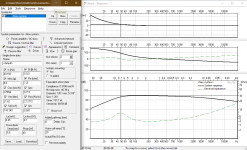 Closed Box + Params.png22 KB · Views: 71
Closed Box + Params.png22 KB · Views: 71 -
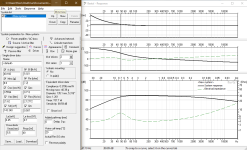 Closed box No params 1.png22 KB · Views: 67
Closed box No params 1.png22 KB · Views: 67 -
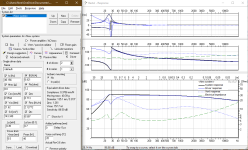 Vented Response + Params.png27.2 KB · Views: 67
Vented Response + Params.png27.2 KB · Views: 67 -
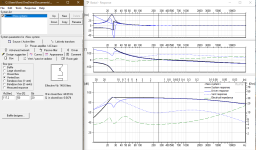 Vented Response Design Suggestion(Initial ideea).png21.5 KB · Views: 71
Vented Response Design Suggestion(Initial ideea).png21.5 KB · Views: 71 -
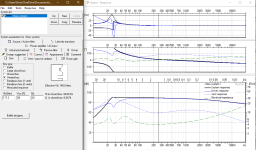 Vented Response No params + Box Type.png21.5 KB · Views: 63
Vented Response No params + Box Type.png21.5 KB · Views: 63 -
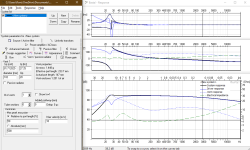 Vented Response No params + Vent Calcs.png22.4 KB · Views: 70
Vented Response No params + Vent Calcs.png22.4 KB · Views: 70 -
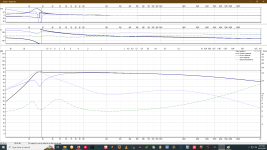 Vented Response No Params.png57.9 KB · Views: 63
Vented Response No Params.png57.9 KB · Views: 63
- Home
- Design & Build
- Construction Tips
- Help in the design of a loudspeaker and ideas to implement
